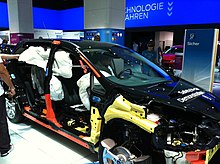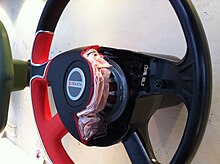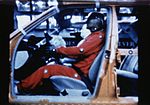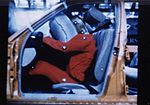Airbag
As airbag (from English air bag , literally airbag ), crash cushions (short air bags ) or SRS ( Supplemental Restraint System , Eng. For Supplemental Restraint System ) is of generally part of the occupant restraint system of motor vehicles and aircraft referred. An airbag is also used in other systems such as the airbag landing system or the avalanche airbag . The airbag in the motor vehicle consists of a plastic sack which, in the event of an accident, unfolds with a loud bang between the occupant and parts of the vehicle interior within 20 to 50 milliseconds . This prevents the occupant from hitting hard parts of the interior such as the steering wheel or dashboard. The airbag system is only triggered by strong negative acceleration values, beyond values that can be achieved by emergency braking alone. Vehicles can be equipped with a variety of airbags. Depending on the vehicle's deceleration and the collision angle, only certain airbags are deployed.
In the industrialized countries , front airbags , side airbags and head airbags are usually part of the standard equipment in new passenger cars . Small vans are usually equipped with a driver airbag as standard, while heavy commercial vehicles are occasionally available for an extra charge.
The airbag is not a replacement for the seat belt , it is only an addition. The statistics shows that the belt remains the main lifesaver in car accidents is.
history
Mass motorization - also in view of the constantly increasing performance of cars - meant that the number of serious and fatal accidents rose steadily. First, various, sometimes absurd, options for effective impact protection were designed. Manfred von Ardenne sketched vehicles with an “inner braking distance” in which shifting seats should dampen the impact energy and the occupants should sit facing backwards in order to be gently pressed into the seats in the event of a frontal collision. However, it mostly remained with theoretical considerations. The Munich inventor Walter Linderer , however, applied for a patent for the airbag as early as 1951. The German Patent Office then issued the patent DE 896312 on October 6, 1951 for a “device for protecting people in vehicles against injuries in the event of collisions”. Walter Linderer is therefore one of the inventors of the airbag. In the USA, John W. Hetrick received a similar patent in 1953. However, these early airbags were not practical due to a lack of sensor and trigger technology. In the USA, Allen K. Breed (Breed Technologies) is a pioneer of modern airbag technology with a system introduced in 1968.
Due to the rapidly increasing number of serious traffic accidents with personal injury worldwide, US President Lyndon B. Johnson announced in the 1960s that unsafe vehicles would no longer be tolerated in the future. The 1966 newly created United States Department of Transportation ( United States Department of Transportation - DOT) demanded that in 1969 adopted package of laws to require automatic occupant protection systems from 1 January 1973, mandatory for new cars.
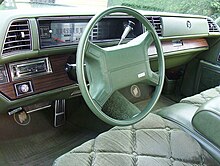
Against this background, the car manufacturers developed various solutions. General Motors decided on an airbag system, which was available under the name "Air Cushion Restraint System" (ACRS) from 1974 at an additional cost. It was offered in the Oldsmobile Toronado , Oldsmobile 88 , Oldsmobile 98 , Buick Electra , Buick LeSabre , Buick Riviera and most Cadillac models , among others . This was an airbag system with a driver and front passenger airbag. The driver's airbag was inflated using a pyrotechnic gas generator, while a two-stage hybrid gas generator was used for the front passenger airbag. Due to economic failure, the system was taken off the market in 1976. General Motors had planned to sell 100,000 vehicles a year with this airbag system, in fact fewer than 10,000 orders were placed during the entire construction period.
In 1997, the installation of front airbags for the driver and front passenger in new vehicles became a legal requirement in the USA. The regulation came into force one year later for SUVs and vans. The regulation is part of the Federal Motor Vehicle Safety Standards (FMVSS).
The first German car with an airbag was the Mercedes-Benz W 126 (S-Class) in 1981 . The combination of driver airbag and front passenger seat belt tensioner was initially only available for an extra charge in the 126 series. The system was manufactured by Aschaffenburger Petri AG (2000 to 2012: Takata-Petri, since 2012: TAKATA AG ). A short time later, it was also used in the Mercedes-Benz W123 .
In the following years, other vehicle manufacturers also equipped their vehicles with airbag systems. Initially, most vehicles were only equipped with a driver airbag in the steering wheel . Since the late 1980s, airbags for front passengers have increasingly been offered by manufacturers. From the mid-1990s, more and more airbag systems were installed in vehicles. The first side airbag in the Volvo 850 followed in 1994, and the first knee airbag in the Kia Sportage in 1996. In 1997, BMW introduced the ITS, the first head airbag for front seat passengers, and in 1998 there were the first side curtain airbags for the front and rear seats in the Volvo S80 . A seat belt airbag was introduced in the Lexus LFA in 2010 and a pedestrian airbag in the Volvo V40 in 2012 .
Airbag systems have also been used in aircraft since 2001. They are used in both commercial aircraft and sport aircraft.
safety
Protection potential
After the seat belt, the airbag is the most important passive safety element. During the massive introduction of airbags between 1990 and 2005, road deaths in Germany fell by more than half. However, during the same period the vehicles were equipped with ESP, more stable passenger cells and other measures to improve safety. It is therefore difficult to assess how great the effect is from the airbag. In a study published by the Federal Highway Research Institute in 2004, the authors assume a potential avoidance of severe or fatal injuries caused by the airbag in frontal collisions for the driver of around 20%. The protection potential of the airbags is also clear in crash tests in which the same vehicle is tested once with and once without the airbag. Here the load values for the occupants in the vehicle without an airbag are usually many times higher than the values for the same vehicle with an airbag.
Front airbags trigger the first violent impact. If there is another impact after the first impact, the front airbag can no longer offer any protection potential, as it has already collapsed. One possibility to contain this weak point is to initiate an automatic emergency stop immediately after the airbag has been triggered.
Damage from airbags
Airbags only deploy in accidents in which the seat belt alone could not prevent fatal or other serious injuries. The triggering can also cause injuries (up to severe head injuries and fractures of the cervical spine) itself. However, the risk of injury is regularly subordinated to the protection potential. Known injuries include minor burns to the forearms from the frictional heat of the expanding airbag fabric. The sudden pressure wave from the inflation of the airbag can lead to hearing damage ( pop trauma ), especially in a small vehicle interior . As the airbag inflation gas contains various fine dusts and gases, asthma sufferers can experience temporary breathing difficulties. In addition, the ignition charge of the airbag can produce toxic components after an explosive release .
Serious and even fatal injuries from the airbag can occur in a so-called out-of-position situation, i.e. if an occupant or another body is in the deployment area of the airbag at the time of deployment. This can be especially the case with very small people sitting too close to the steering wheel or with passengers who put one foot on the dashboard. Objects that are positioned between the airbag and the occupant can be thrown towards the occupant at high speed when the airbag is triggered. For example, if a rear-facing child seat is used on the front passenger seat, the front airbag there must be deactivated, otherwise it can lead to fatal injuries. If the airbag cannot be switched off, the baby seat belongs on the back seat (see also baby seat mirror ).
Between 1990 and 2007, the American traffic safety authority NHTSA recorded 284 deaths in the USA that were attributable to airbag deployment. 180 children and 104 adults were killed. In contrast, there were an extrapolated 24,334 rescued people.
In 2014, the American Traffic Safety Administration NHTSA urged the airbag manufacturer Takata to the recall of all installed front airbags in the more humid southern states of the United States because there had been five deaths (four in the US, 1 in Malaysia) that uniquely on Schrapnellverletzungen by Metal splinters flying around as a result of regular and incorrectly triggered driver airbags. The reason for the incorrect deployment of the airbags was the switch from the explosive tetrazole to the explosive ammonium nitrate in 2001. Ammonium nitrate is sensitive to changes in temperature and humidity and decomposes over time, which can result in compounds that are more prone to explosions and which can lead to incorrect airbag deployment. The reason for the change was that ammonium nitrate can be produced much cheaper than tetrazole. In May 2015 Takata was forced by the NHTSA to extend the recall to all affected vehicles in the USA. 33.8 million cars are affected.
Rescue workers
In the event of accidents in which not all airbags have triggered, vehicle-specific safety measures must be taken when using hydraulic rescue equipment. The AIRBAG rules must be observed. To ensure that there is no danger to the rescue workers, a rescue guide (or rescue card ) is offered for many vehicles , which can be carried in the vehicle. In addition to other relevant hazards, it describes the location of airbags and gas generators in the vehicle. There is also a special airbag protector that is pulled over the steering wheel.
functionality
Sensors
Airbags are usually triggered by a central airbag control unit. Some airbag systems in compact cars from the early 1990s are an exception . For reasons of cost, systems with a mechanical trigger integrated into the airbag module were used here. Due to the difficult handling during disposal and the very rudimentary coordination of the trigger characteristics, these systems disappeared from the market after a short time. In today's vehicles, the airbag system consists of the components airbag module, airbag control unit and crash sensors. The airbag module contains the actual nylon bag and the gas generator. The crash sensors are part of the control unit installed, distributed partly as satellite sensors in the vehicle. The most important sensors for triggering are the acceleration sensors . In order to avoid false triggering, at least two acceleration sensors are always installed. The airbag is only deployed if both independently report a corresponding delay. Pressure sensors are often used to detect side collisions . In the event of a side collision, these sensors report a rapid increase in pressure inside the door, even before the vehicle accelerates. This enables side collisions to be detected at an early stage. In addition, a large number of other sensors are used, such as seat occupancy detection on the front passenger seat, seat position sensors in the driver's seat and contact switches in the seat belt buckles. The control unit constantly compares the sensor data with stored values. Based on the data from the sensors, the control unit decides whether it is triggered and which airbags and seat belt tensioners need to be activated. The control unit has internal capacitors and is therefore fully operational for a short time, even without an external power source, in order to be able to deploy the airbags in the event of an accident even if the vehicle battery has already been disconnected during the ongoing accident.
Gas generator
Gas generators provide the gas for filling the airbag. To reduce the airbag aggressiveness, two-stage gas generators are sometimes used for front airbags. The first stage usually contains around 70 percent of the propellant charge. Due to the vehicle deceleration, seat adjustment and possibly other parameters, both stages are ignited at the same time or at different times. If the second stage is ignited with a delay, the airbag pressure is reduced and thus its aggressiveness.
Pyrotechnic gas generators
The gas generator consists of an ignition unit and the solid fuel. The lighting unit is activated by a current pulse from the control unit. This ignites the solid propellant , which is usually in tablet form. The resulting hot gas (≈ 1350 ° C) flows through a metal filter from the gas generator into the airbag. The filter is necessary to hold back larger particles in the combustion chamber. Otherwise these would damage the airbag. As a result of the expansion, the temperature of the gas flowing into the airbag is only around 150 ° C. Since the beginning of the nineties attempts have been made to replace the toxic sodium azide as a fuel with more environmentally friendly explosives. There are three alternatives: Nitrogen-rich organic compounds (e.g. 5-aminotetrazole) in combination with inorganic oxidizing agents (such as alkali or alkaline earth nitrates ), cellulose nitrate in combination with nitrate esters of polyols (e.g. nitroglycerin ) or oxygen-rich , nitrogen-free organic compounds (e.g. citric acid ) in combination with chlorates or perchlorates.
Cold gas generators
The gas generator consists of a gas reservoir and an activator. A gas, usually a helium - argon mixture, is stored under high pressure in the gas storage tank . When the airbag is triggered, an explosive device destroys a membrane and the cold gas flows into the airbag. These systems are mainly used for side curtain airbags, since a lower filling gas temperature has to be achieved in order to extend the service life.
Hybrid inflators
Hybrid gas generators are a combination of a pyrotechnic generator and a cold gas generator. They therefore contain both a pyrotechnic charge for gas generation and a pressure accumulator with pretensioned gas.
Front airbags
The front airbags are deployed around 15 ms after the start of the impact. The airbags are fully deployed after just 50 ms. Immediately afterwards, the occupants dip their heads and chests into the fully inflated airbags and force the air out again through holes on the back of the airbag. After 150 ms the airbags are completely deflated again. The protective effect is based on the fact that the head is supported and an even load distribution is achieved on the chest. Without an airbag, the driver's head would be thrown far forward, the cervical spine would be overstretched and the head would eventually hit the steering wheel or dashboard.
| Live photos of an opening airbag | |||
|---|---|---|---|
In the scope of the ECE regulation , front airbags are always designed as an additional restraint system (SRS). However, in the United States ( FMVSS ) they must also be designed to prevent serious injury to occupants who are not wearing a seat belt. At the same time, there are strict regulations in the USA regarding the limitation of airbag aggressiveness towards very small occupants and so-called out-of-position cases (OOP). Against this background, adaptive front airbags are used today in the USA, the strength of which can be varied depending on the strength of the impact or the size of the occupants.
Driver airbag
The airbag module is located in the middle of the steering wheel. During the 1990s, when airbags were still a mostly chargeable accessory, driver airbags of different sizes were installed. Some European manufacturers offered so-called "Eurobags" with a volume of only 35 liters in order to reduce the price of the system. Other manufacturers and in the USA only used "full-size airbags" with a volume of approx. 65 liters. There were no notable differences in occupant protection. The airbag volume in vehicles from the 2010s is between 45 and 60 liters. The contact to the connection to the steering wheel is made via a loosely wound spiral-shaped flexible circuit board .
Passenger airbag
The airbag module is usually integrated in the dashboard , usually above the glove compartment. An exception is the Citroën C4 Cactus , where the airbag module is built into the roof. The airbag volume in today's vehicles is 80 to 120 liters. The front passenger airbag can be deactivated manually or automatically in many vehicles, as it is a danger for babies in rear-facing child seats (reboard systems).
Side airbag
They unfold within 20 ms between the seat and the door panel and are intended to reduce the risk of injury to the upper body by supporting the occupant over a large area on the chest and pelvis and relieving the stomach area.
Side airbags in the door panel
Thorax airbags in door panels are no longer used today. This type of airbag is now integrated into the seat.
Side airbag in the seat
Can be designed as a pure thorax, as a thorax / pelvis and even as a thorax / pelvis / head airbag. Side airbags for the front seats (driver's seat and front passenger's seat) are usually part of the standard equipment due to the requirements of the Euro NCAP crash tests . Side airbags for the other rows of seats are usually not standard equipment, but some are available as optional equipment.
Several separate airbags can also be installed in the seat. Since 2009, Mercedes has been using two side airbags per seat in some vehicles, one at chest level and one at pelvic level. Mercedes calls this airbag a pelvisbag. With all airbag systems of whatever type integrated into the seat, only protective covers that are approved for this purpose may be used. They have a tear seam in the area of the airbag and therefore do not hinder it during its deployment process.
Head airbags
Head airbags are intended to prevent contact with the side window, B-pillar or penetrating objects and to support the head over a large area in order to avoid lateral hyperextension of the cervical spine . They are activated in the event of a side collision. Depending on the manufacturer, they are also activated in the event of rollover and severe frontal collisions.
Curtain airbag
It unfolds along the side window front and covers the entire pane areas. They stay inflated for around 5 seconds and thus protect against rollover or multiple collisions. In convertibles, the head airbag cannot be installed in the roof. This is why the head airbag is integrated into the door panel on some convertibles.
Head airbag in the seat
This system is often used in convertibles and inexpensive vehicles. However, it offers no protection in the event of multiple collisions and only little protection in the event of rollovers. They are mostly used as a combined thorax / head airbag, but Peugeot also uses it as a single airbag in the Peugeot 308 CC .
Other airbag systems
Knee airbags
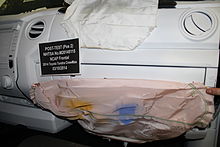
Knee airbags are located in the lower part of the dashboard. They are intended to prevent both the shins from hitting the dashboard and the passenger from slipping under the seat belt by supporting it. Knee airbags are usually only installed for the driver, rarely also for the front passenger.
Seat cushion airbag
Seat cushion airbags (also anti-submarining airbags or anti-sliding airbags ) are located in the front part of the seat surfaces of the front seats. They are designed to prevent slipping under the belt. In some vehicles, the airbag is only in the front passenger seat, in others in both front seats.
Rear seat airbag
In 2009, a rear seat airbag was launched in series on the Japanese market . The air cushion is located in a large center console between the two rear seats and inflates between the two rear passengers. Available in the Toyota Crown Majesta .
Rear airbag
The rear airbag is located in the roof space in front of the rear window. It is designed as a curtain airbag and unfolds between the head restraints and the rear window. It is intended to reduce the risk of injury to rear passengers in the event of a rear-end collision. The Toyota iQ is currently (2017) the only vehicle with a rear airbag.
Seat belt airbag

plane
The airbag is located in the belt of the lap or shoulder belt. In the event of an accident, it shoots upwards from there and, when triggered, is located directly in front of the occupant's chest and head. This avoids impact on the cockpit or front seats. It is used in small aircraft to support the three- or four-point seat belt as well as in large traffic machines in combination with two-point belts.
Motor vehicle
It is an inflatable seatbelt. In the event of an accident, it is inflated in the area of the occupant's chest . In this way, a greater and more even distribution of force on the occupant's chest can be achieved than with a normal belt, which reduces the risk of injuries.
Pedestrian airbag
This airbag unfolds in the event of a collision with a pedestrian over parts of the outer skin of a car, such as B. the lower third of the windshield and the A-pillars.
Motorcycle jacket with airbag
As part of the protective equipment of motorcyclists, motorcycle jackets with airbags are offered. In this case, the airbag is triggered mechanically via a pull cord.
Newer systems now work wirelessly with an electronic control module attached to the motorcycle.
Motorcycle airbag
- For the first standard motorcycle airbag see: Honda Gold Wing (Section: Motorcycle Airbag) .
- For the first standard airbag system on the driver, see: Ducati Multistrada 1200 (section: Airbag system on the driver) .
Cyclist airbag
The world's first airbag for cyclists, the Swedish Hövding , is wrapped around the neck like a scarf and reacts to a fall using sensors. After less than a second, it encloses the head and protects it from the impact. It is available in different designs in specialist shops.
Legislation
In the past, automobile manufacturers have generally recommended replacing airbag units after certain periods of time in order to ensure functionality, generally after around ten years. In the meantime, however, manufacturers can observe an expansion of these intervals. There is no legal obligation to replace expired airbags.
Germany
Airbag and belt tensioner units are subject to the regulations of the Explosives Act and are therefore pyrotechnic items of category P1 ( Section 3a SprengG Paragraph 1 Item 3a in conjunction with Section 4 of the 1. SprengV Paragraph 1 and Paragraph 3). Installation and removal, storage or distribution are generally only permitted to people with at least limited specialist knowledge (6-hour course) as part of a commercial activity, as is the destruction of airbag or belt tensioner units if these are permanently installed in a vehicle. Any other handling of it is excluded as long as the unit is permanently installed in a vehicle or part of the vehicle, as well as, of course, its intended use with automatic activation
The trade in used airbags z. B. in the course of car recycling is not allowed. According to the end-of-life vehicle ordinance , airbags from every end-of-life vehicle must be removed or deployed immediately after delivery to the dismantling company by trained specialist personnel according to the manufacturer's specifications for disposal in the specialist company.
Airbags must be stored in accordance with Explosives Storage Guideline 240 “Storage of airbag and belt tensioner units”. According to this, a maximum net explosive mass of 10 kg must not be exceeded when stored in work rooms. For storage in storage rooms or for mobile storage, a maximum net explosive mass of 100 kg is permitted. In principle, storage may only take place in commercially used rooms.
Austria
In Austria, the handling of pyrotechnic objects is regulated in the Pyrotechnics Act. According to Section 15 of this Act, pyrotechnic objects or sets of category P1 (e.g. airbags and belt tensioners) may only be owned or used by people who are at least 18 years old.
literature
- Florian Kramer: Passive safety of motor vehicles. 3. Edition. Vieweg + Teubner Verlag, Wiesbaden, 2009, ISBN 978-3-8348-0536-2 .
- Hans-Hermann Braess, Ulrich Seiffert: Vieweg manual automotive technology. 2nd Edition. Friedrich Vieweg & Sohn Verlagsgesellschaft, Braunschweig / Wiesbaden, 2001, ISBN 3-528-13114-4 .
- Karl-Heinz Dietsche, Thomas Jäger, Robert Bosch GmbH: Automotive pocket book. 25th edition. Friedr. Vieweg & Sohn Verlag, Wiesbaden 2003, ISBN 3-528-23876-3 .
- Book of tables automotive technology. 15th edition. Verlag Europa-Lehrmittel, 2005, ISBN 3-8085-2125-2 .
Web links
- Further information on insassenschutz.50webs.com
- More information on roru.de
- Airbag information for rescue workers (PDF file; 52 kB)
Individual evidence
- ^ Airbag - Duden , Bibliographisches Institut 2016.
- ↑ air bags - Duden , Bibliographical Institute ; 2016.
- ↑ volvotrucks.co.uk ( Memento of the original from March 5, 2017 in the Internet Archive ) Info: The archive link was inserted automatically and has not yet been checked. Please check the original and archive link according to the instructions and then remove this notice.
- ↑ a b Study "Accident injuries in vehicles with airbags", prepared by ADAC / GDV / IFM, published by the Federal Highway Research Institute (PDF; 2.4 MB)
- ↑ Via vehicles with internal braking distances. In: Automotive Technology . 2/1960, pp. 52-54. and 11/1960, pp. 453-457.
- ↑ Key Advanced Air Bag Legislative History ( Memento from February 22, 2014 in the Internet Archive ). Retrieved February 19, 2014.
- ↑ General Motors: Air Cushion Restraint System. Prospect from Oldsmobile to the ACRS. 1974, accessed February 20, 2014 .
- ↑ 1974-1976 Cadillac, Buick, and Oldsmobile Air Cushion Restraint System (ACRS) . Retrieved February 19, 2014.
- ↑ General Motors 1973–1974-1975-1976 'ACRS' air bag history (English; accessed February 19, 2014)
- ↑ Standard No. 208; Occupant crash protection . Retrieved February 19, 2014.
- ↑ World premiere for safety: Airbag in the S-Class of the W 126 series ( Memento from February 10, 2014 in the web archive archive.today ). Retrieved February 19, 2014.
- ^ Volvo Car Corporation: Volvo Cars airbag celebrates 20 years. May 24, 2007, accessed October 20, 2017 .
- ^ Lesley Wright: New Air Bag Will Aim For Knees, Legs. May 24, 1996, accessed October 20, 2017 .
- ↑ theautochannel.com
- ↑ Inflatable Tubular Structure (ITS). (No longer available online.) Archived from the original on January 9, 2015 ; accessed on October 20, 2017 (English).
- ^ Volvo Car Corporation: Volvo S80 Press Material. In: volvoclub.org.uk. 1998, accessed April 7, 2017 .
- ↑ us.aving.net
- ↑ Joshua Dowling: Volvo offers world's first pedestrian airbag. February 17, 2013, accessed October 20, 2017 .
- ↑ Airbags in the airplane . Retrieved February 20, 2014.
- ↑ Crash test VW Polo with and without front airbags
- ↑ ADAC test multi-collision brake
- ↑ Michael Rohm and Karl-Heinz Schimmelpfennig: Investigation of the sound pressure exposure of car occupants through airbags ( Memento of the original from January 22, 2012 in the Internet Archive ) Info: The archive link was automatically inserted and not yet checked. Please check the original and archive link according to the instructions and then remove this notice. , 2007 in traffic accident and vehicle technology
- ^ John B. Sullivan Jr., Gary R Krieger: Clinical Environmental Health and Toxic Exposures.
- ↑ Tests on Airbags: Analyzes of Gases, Dusts, Structures and Squibs ( Memento from February 2, 2014 in the Internet Archive )
- ^ KB Gross, AH Haidar, MA Basha, TL Chan, CJ Gwizdala, RG Wooley, J. Popovich, CJ Cwizdala: Acute pulmonary response of asthmatics to aerosols and gases generated by airbag deployment. In: American journal of respiratory and critical care medicine. Volume 150, Number 2, August 1994, pp. 408-414, doi: 10.1164 / ajrccm.150.2.8049823 . PMID 8049823 .
- ↑ General Motors technical training (PDF; 806 kB)
- ↑ Tests on Airbags: Analyzes of Gases, Dusts, Structures and Squibs
- ↑ Secondary accelerated foreign bodies as a source of danger when an airbag is deployed
- ↑ ADAC tips on securing vehicle occupants correctly ( Memento from February 7, 2014 in the Internet Archive ) (PDF; 2.7 MB)
- ↑ National Highway Traffic Safety Administration Airbag Fatalities (PDF; 3.1 MB)
- ↑ smh / dpa: Defective Takata airbags: car manufacturers in the USA threaten another mass recall. Spiegel Online, November 19, 2014, accessed November 20, 2014 .
- ^ Neil Gough, Jonathan Soble, Hiroko Tabuchi: Defective Takata Airbag Grows Into Global Problem for Manufacturer. In: New York Times. November 18, 2014, accessed November 20, 2014 .
- ↑ Hiroko Tabuchi: Takata's Switch to Cheaper Airbag Propellant Is at Center of Crisis. In: New York Times. November 19, 2014, accessed November 20, 2014 .
- ↑ Record recall due to airbag defect. In: Tagesschau. May 19, 2015, accessed May 20, 2015 .
- ↑ Rudolf Meyer et al: Explosives. Wiley, 2007, ISBN 978-3-527-31656-4 , pp. 19-20.
- ↑ zeit.de
- ↑ youtube.com
- ↑ wirtschaft-regional.de
- ↑ spiegel.de
- ↑ motorblatt.de
- ↑ autonews.com
- ↑ takata.com ( Memento from March 5, 2017 in the Internet Archive )
- ↑ youtube.com
- ↑ n-tv.de
- ↑ Toyota Crown Majesta: More airbags than ever
- ↑ amsafe.com ( Memento from June 18, 2012 in the Internet Archive )
- ↑ Technische-hilfeleistung.info
- ↑ ford.com
- ↑ Jörg Lohse: Purchase advice airbag systems for motorcyclists - motorcycle clothing . ( motorradonline.de [accessed on February 9, 2017]).
- ↑ Airbag for cyclists. In: BlickPunkt. April 4, 2015, p. 7.
- ↑ § 4 Paragraph 1 1st Explosive Ordinance
- ↑ § 4 Paragraph 3 1. SprengV
- ↑ 3.2.2.1 of the appendix to the End-of-Life Vehicle Ordinance
- ↑ berufssicherheit.de ( Memento from February 21, 2014 in the Internet Archive )

